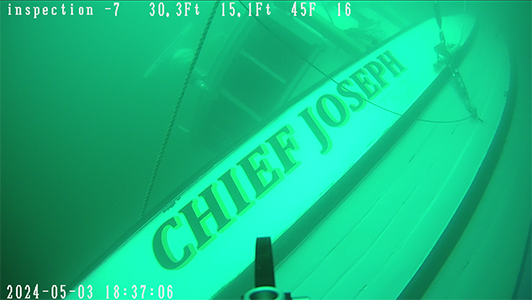||| BY MATTHEW GILBERT, theORCASONIAN OP-ED REPORTER |||
After three years of passionate public comment, Planning Commission debate, and County Council smoke signals, the idea of setting caps on the number of vacation rental permits in San Juan County is finally on the verge of resolution as the moratorium approaches its July 13 sunset date.
There are currently four options on the table, each with different implications:
A. Compliant on July 31, 2021
The Planning Commission recommended setting countywide and by-island caps on vacation
rentals based on the number of permits that were “compliant” on July 31, 2021, whether or not
they were active. Those numbers would look like this:
- Countywide: 650
- Orcas: 334
- San Juan: 229
- Lopez: 85
- All other islands: 2
B. Active and Compliant on July 31, 2022
The now-quaint notion of setting a permit cap considerably lower than what is currently “compliant” to those that are both compliant and active was an early battle cry from the largely Orcas-based Vacation Rental Working Group and is still officially on the table, but few believe it has any chance of success.
- Countywide: 413
- Orcas: 211
- San Juan: 140
- Lopez: 60
- All other islands: 2
C. Originally Proposed by Council
The original number of 1,200 floated by the County Council has quietly haunted the
proceedings, described by planner Sophia Cassam at the April 5 meeting as representing a
“moderate” increase.
- Countywide: 1,200
- Orcas: 500
- San Juan: approximately 500
- Lopez: more than the current total of 130
- All other islands: undetermined
D. Compliant at the Date of Adoption
An arguably “middle of the road” option is to set caps at the number of compliant permits at
the date the ordinance is adopted, which roughly looks like this (for now):
- Countywide: 1042
- Orcas: 508
- San Juan: 392
- Lopez: 134
- All other islands: 8
These figures, however, are moving targets, as the final number of compliant permits will be influenced by the number of new applications that are accepted and the result of enforcement efforts on permits that are currently not compliant. According to Cassam, 200 permits have been abandoned, another 100 are in limbo because they are not compliant, and about 20 new applications are in the queue. The net result, she projects, would be 750 – 800 by the ordinance adoption date.
Department of Community Development Director David Williams noted that the County needs to establish a “legal add,” and suggested setting it at the highest recommended number as a “do not exceed”: 1,200. That figure was approved later in the meeting.
Familiar Fault Lines
The contentiousness over setting a VR cap has exposed certain ideological rifts on the Council. Members Jamie Stephens and Christine Minney have consistently leaned in favor of a more lenient cap (if one is to be set at all), while Cindy Wolf has pushed hard for a lower ceiling. In the Council’s March meeting, for example, she stated that the county’s Comprehensive Plan “requires us to use all the levers and mechanisms available to create market conditions that serve all income groups,” arguing that a continued proliferation of vacation rentals will keep upward pressure on rental and housing costs, pricing out the “missing middle.” Stephens was unconvinced, contending that any such escalations are the result of market conditions and have little impact on realistic affordability.
At the recent April meeting, Wolf noted that with 5,000 residential units on Orcas, the number of permitted VRs of 508 in “compromise” Option D would represent 10% of all homes. Given that 40% of those 5,000 units are summer-only, however, that 508 becomes 15%. And, she continued, if that 500 was to turn over every week in the high season, it would (hypothetically) fill 10 ferries. “The pain (on Orcas) started back in 2019,” she said, when the number of active and compliant rentals was barely above 200 on Orcas. Minney and Stephens were not impressed and continued to push back.
Whatever the mathematics of Wolf’s analogy, the wisdom of allowing a larger short-term rental base remains a litmus test of the county’s tolerance for tourism growth and its mixed social, economic, and environmental impacts. It may not matter on San Juan or Lopez, and so the Minney-Stephens axis will likely rule on a final number. But the Council is certainly capable of customizing the allocation, and if Orcas can still get close to what it wants whatever the overall county cap, then the three years of exhaustive debate will have been worth it.
At this point, the process is out of the public’s hands. The Council believes it has all the feedback it needs and will go straight to a public hearing on a final ordinance, to be held Tuesday, May 17, at 9:15 a.m. Of course, by that point the ordinance will likely be immune from revision, so send closing comments to vrcomments@sanjuanco.com and/or visit the 2021 Vacation Rental Code Amendment webpage.









Councilors Minney & Stephens,
Please have mercy for Orcas Island.
We are at the epicenter of the short-term vacation rental impacts.
We appreciate Councilor Wolf standing up for our island!
I do not understand where the compromise would lie in setting an Orcas VR cap around 500.
The unsuitability of choosing 500 has been explained clearly by Councilor Wolf:
Matthew Gilbert reporting:
“At the recent April meeting, Wolf noted that with 5,000 residential units on Orcas, the number of permitted VRs of 508 in “compromise” Option D would represent 10% of all homes. Given that 40% of those 5,000 units are summer-only, however, that 508 becomes 15%. And, she continued, if that 500 was to turn over every week in the high season, it would (hypothetically) fill 10 ferries. “The pain (on Orcas) started back in 2019,” she said, when the number of active and compliant rentals was barely above 200 on Orcas. Minney and Stephens were not impressed and continued to push back.”
If you feel that your constituents on Lopez and San Juan Islands are fine with the higher proposed numbers, then it is within your powers to decide for your home islands.
But please have mercy for Orcas Island and listen to Councilor Wolf.
Thank-you for your attention to this important decision.
No matter what kind of cap is decided on, and there definitely should be one, the only way it will work if it is also ruled that the VR permit does NOT run with the land, but expires on sale of the property., the way long term rentals now do. This, then would give new applicants a chance, whereas otherwise, the cap may prevent new, needy applicants from benefitting. There needs also be a yearly or so re- permitting fee and compliance check (this may already be in place_)
I appreciate the hard work that has gone into getting to this point….thank you.
Thanks to Cindy Wolf for her persistence and incisive debate on behalf of the Orcas community. It seems unfair that representatives of the other islands have the power to overrule Orcas’ representative.
The Orcas Councilwoman’s misguided push for a vacation rental cap will not solve the problems of over-tourism and lack of affordable housing. Tourist accommodations would then be supplied by hotels, resorts and inns. Those second home owners that might rent their home as a vacation rental would simply keep their home empty for their own vacation use.
It is interesting that the loudest voices advocating caps are mostly NIMBYs with fear that their 10 acre home might be intruded on or they might hear parties from VR’s that are 500 feet away. But the truth is that most complaints about bad neighbors have to do with long-term renters, not vacation rentals.
What almost everyone seems to be missing — or deliberately ignoring — is that short-term vacation rentals are COMMERCIAL OPERATIONS located in residential neighborhoods. Yes, I know the state court of appeals ruled otherwise, but courts don’t always get things right, witness the infamous Dred Scott Decision. And we have laws, or at least zoning restrictions, in this county against overtly commercial operations in residential areas. Thus it seems obvious that VRs should be strictly limited, so as not to convert residential areas into commercial districts. Ten percent seems a reasonable limit most of us can live with.
I really regret voting for Minney. This is NOT what she promised during her campaign.
So glad we have focused such a tremendous amount of energy on Vacation Rentals as the primary insidious actor in our community, while literally offering ZERO improvement to county development codes and regulations that will actually do something proactive to help residents and employers with the housing crisis. Whatever the “cap” is, it will have essentially no impact on affordability or rental availability in San Juan County.
It will be good to put this issue to bed so that the hundreds of hours of repetitive debate that have been dedicated to this issue can finally be put towards something that might actually have an functional output.
In fact, the VR issue will not be “put to bed” unless a meaningful solution is enacted by the County Council. Hundreds of people, and not just Orcasonians, have spoken out and signed petitions and attended public meetings to protest the invasion by commercial VR business operations into residential settings. Over 6200 SJC residents voted for Councilmember Wolf who promised “Day 1” focus on the issue. And all of this outcry was produced by the presence of legal, actively rented VRs which numbered plus or minus 413 as of July 2021. That’s active, not inactive, permits. If the cap ends up including the hundreds of inactive permits, creating a massive future liability on our home environment, the issue will surely not be put to bed.
The “affordable housing” argument is but a deflection from the basic issues. As the real estate professionals have testified, when a VR permit is applied to a residential property, it experiences an immediate bump in market value. In fact, comparable properties without permits may also show the market gain. So, as long as VR permits are attached to properties, and are transferable to future owners, the impact of VRs on affordable housing will be felt. But this is not a reason to fail to enact the cap.
I am compliant… I am not active. If there is the least chance that I might lose my ability to use my property as a vacation rental if I ever so wish… Then I will abandon my countless hours of volunteer work on housing in order to get active as quickly as I can. Although not currently using my house as a vacation rental the plan was to have the ability to use it in the future for retirement purposes in order to stay on the island where I love my community. If my ability is threatened threatened to come to an end then I will do everything I can to start my vacation rental up as soon as possible and become active. I’d prefer to continue spending my time helping community… I’ve heard it said that there is no risk. If it is listed in the possible outcomes it is a risk.
I have given up enough of my own income by choosing community instead of personal gain. Volunteering does not pay property tax. I currently owe $8,000 Plus for this year alone. I’ll continue volunteering if someone wants to pay my property tax for me. That seems doubtful. Putting my focus into opening my vacation rental as active seems my only choice to ensure I do not lose the ability for the future. My property would never be a long-term rental as I use the property myself.
Put to bed, resolved, partially figured, somewhat handled…
Say it however you want.
Vacation rental permits are 100% absolutely disconnected from what the working class of Orcas Island deems “affordable”. The affordability ship sailed long ago. As has been pointed out ad-nausium, nothing in the market currently will sell at price that will ever fall within the affordability range for the working class – permit attached or not.
I’m completely in favor of a cap. I trust council to set an appropriate number, and to do so in a manner that does not affect current permit holders’ rights. I applaud all 3 council members for listening and making sure to represent all sides of the debate. Many of us simply stopped providing input because our voices were simply drowned out.
Now… it’s well past time for the Council to get to work on creating necessary changes to the development code that allows property owners, business owners and all those looking for solutions to the housing crisis to do what is required to sustain our community. It’s time for the obstructionist special interests who planted the seeds of this issue in our code 20 years ago to get out of the way so that we create a viable path forward to logical, sustainable and environmentally appropriate development.
Well said, Justin!
I think that every place in the world that attracts visitors really should have a sustainable tourism plan in place for simple ecological carrying capacity reasons. And with an island, that might mean hard limits on occupancy of all kinds. Because, at the end of the day, what real difference in impact on the island is there between one weekend visitor and one annual renter or one summer resident or one full time resident? People are going to use just about the same amount of resources and services per day however long they actually stay on the island. So I ask you, can you identify vacation rental people on the street or trail? No, of course you can’t, because they are just people like you and I. So then, how do you know there are too many? You just see people you don’t know and assume they are tourists. This leads to the conclusion that we don’t have too many tourists, we simply have too many people. Period. And how do you regulate that without revising our entire legal code?
Michael Riordan – You really should read the county code for allowed activities in different zoning categories. It’s not just commercial vs residential – 18.30.030 Land use table – https://www.codepublishing.com/WA/SanJuanCounty/#!/html/SanJuanCounty18/SanJuanCounty1830.html
I personally think that Iif the specified higher density areas of the county want to restrict VRs within their boundaries, they should be able to come together and vote to do that. Unfortunately, there are no provisions for that kind of ‘town hall’ direct democracy in this county. We have a representative democracy, like it or not, and the county council will decide for the whole county. If that makes some people unhappy, perhaps they should consider convincing everyone to revise the form of government we use? Despite the naysayers, I still think that incorporating Orcas Island as a municipality is the most straightforward way to have local control. Just be aware that your property and sales taxes will undoubtedly go up!
News from the Washington Post: One HOA in Charlotte, NC has imposed a rule requiring any new home buyer to wait 2 years before renting it out. That reduced purchases by over 50% and shows that there are ways to limit renters from being part of the community.
Ken, my core point is that at a certain point, vacation rentals inevitably become oppressive and destructive of community—especially in genuine neighborhoods like the one I live in. That point, I believe, occurs at 10 percent VRs, but others may prefer lower or higher.
Please note that according to Option B above, the number of VR permits on Orcas is 211. These are the “Active and Compliant on July 31, 2022” permits. The 508 that Cindy Wolf mentions includes all the permits that have been issued. These rentals will not all be active at the same time, they will not all rent 360 days a year, and they will undergo natural attrition. A more accurate number of rentals that are actually bringing tourists to the island will be somewhere in between 211 and 508.
As a caller said at the last council meeting, “The sky has not fallen”. Having looked more closely at the overall situation, the situation is much less dire than the VRWG originally put forth. And, importantly, there is much more support for VRs than was obvious at the beginning of this Moratorium.
What we need – what has not yet happened since 2018 – is timely and consistent ENFORCEMENT. The compliant rentals are following the strict regulations that address neighborhood concerns. The unregulated rentals are not. We need to stop the bad actors from renting.
We need the reasonable caps of Option C that allow options for our middle class, and we need enforcement.
This continued waste of time and of course your money, concentrated on attacking cottage industry business such as short term rentals, truly illustrates the total disregard of the problem of housing on these Islands. Not one dime or ounce of time has been spent trying to rezone land use for more density housing, nor maybe even using the enormous amounts of Land grabs, by the Land Bank to place low income housing has never even be brought up. You know why? because those that can’t live here don’t have a voice, but that small group of anti tourism “Vacation Rental Study Group” otherwise known as “I live here, you don’t need to come here study group” has installed their own Council persons to do their bidding and not what is best for the Islands they Govern. You legislatively cannot as a governing body of free Citizens and Free Enterprise implement legislation that may be subject to Law Suits, without establishing an answer to the following question: “What is the actual real, established, proof of such, problem, that is plaguing this Island from legal, and restricted, and heavily legislated, short term rentals. Not one iota of proof or fact has been introduced in any and all of this many years of samo samo hearings. Its time to go on to other things.
Back to Justin’s comment, I think it would be helpful to know what changes in the development code he would recommend.
Mathew,
Thanks for asking.
There are several which the council should be considering and examining. Here’s a couple thoughts.
First and foremost, council should be revisiting the “guest-house” discussion of 20 years ago, in which the county was bullied into restricting small ADU development on rural lands. We were sold the concept that “double density” would cause an unsustainable population spike.
Allow rural land owners (think R-5) to build a >1000sq ft small home on their property with a note to title that it could not be a vacation rental ever, normal requirements for water, sewer, screening and setbacks. Provide property tax based incentives that encourage that home to be rented according to an affordable scale and on a yearly based lease term. Many land owners and business owners would jump at the chance to provide housing for family and employees if given the chance, immediately creating affordable housing … at ZERO cost to the county
Second- we need to be critically looking at how to get out of the most restrictive and nonfunctional portions of the GMA, which was needlessly adopted in our county. By forcing development into I’ll-defined concentrations which have no administrative connection to the utilities required to serve them we have put undue burden on the ecology of those spaces. The GMA has forced us to create disconnected zoning and use in improper spaces. It was a bad law for SJC when adopted, which is why the state gave us the option of opting out. We, unfortunately, got scared into opting in.
Perhaps the county should be looking at taking some emergency actions to discourage homelessness? Currently anyone living in a trailer is subject to being tossed out if they have been there greater than 180 days. Our code makes a very common living situation illegal. Right now, RVs and trailers provide a substantial source of affordable living spaces for our county residents. These are our teachers, our care-givers and our beginning families. Rather than focus on driving this “illegal” activity under the radar, let’s find ways to allow it in a way that assures that our ecology is protected along with our working families.
Ok… there’s a couple you can chew on, and maybe it can help fill the hundreds of hours of council and planning committee time that will be available once they stop talking about vacation rentals.
I agree with Justin’s comment. Restoring ADUs as a matter of right, but restricted to family/guest use or long-term rentals only would increase the supply of affordable rental housing. Existing,”active” VR owners, provided they are live on-site, would be “grandfathered” as long as they own the property.
I love seeing the guesthouse discussion revived. Eliminating them was a mistake.